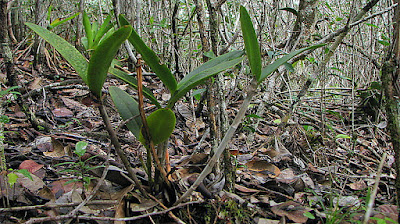Cattleya granulosa is native to Brazil. These plants are found in the hot, humid lowlands around Recife in the state of Pernambuco. They usually grow on shrubs and small trees in coastal swamps flooded during the rainy season...
Cattleya granulosa also called as Granulose Cattleya, Cattleya buyssoniana, Cattleya granulosa var. buyssoniana, Cattleya granulosa var. russeliana, Epidendrum granulosum, is a species of the genus Cattleya. This species was described by John Lindley in 1842.
IDENTIFY CATTLEYA GRANULOSA
Cattleya granulosa is native to Brazil. These plants are found in the hot, humid lowlands around Recife in the state of Pernambuco. They usually grow on shrubs and small trees in coastal swamps flooded during the rainy season. There are also reports of the presence of these plants in the Paraíba and Ceará states.
It is a stout, large sized, warm to cool growing, upright epiphyte, which reaching 25-60 cm in height, with elongate, cylindrical, laterally, 25-60 cm long, compressed pseudobulbs carrying 2 apical, oblong-lanceolate, or elliptic-ovate, coriaceous, obtuse, 7-12 cm long leaves.
Granulose Cattleya blooms in the spring and early summer on a terminal, short, 5 to 8 flowered inflorescence with glossy and thick, long-lived, fragrant, color variable flowers. The flowers are up to 8.5 cm diameter. The outer whorls are long and quite narrow. The inner whorl flakes are very narrow at the base, but much wider in the apical part, with very curled and more or less deflected edges. Normally the petals of both whorls are olive green with amethyst spots. The 3-segment lip is white and usually has a yellow-orange half at the base. Large side plots, each curved so that it covers the rod, are white on the outside and pale yellow inside. At the base, the middle plot is narrow, but extends into 2 rounded plots at the top. It also has slightly wavy edges, and the upper surface is covered with a variable number of delicate, velvety, amethyst-colored, bulging spots that look like granules.
CATTLEYA GRANULOSA CARE AND CULTURE
Cultural information should only be used as a guide, and should be to be adapted to suit you. Your physical location; where you grow your plants, how much time you have to devote to their care, and many other factors, will need to be taken into account. Only then can you decide on the cultural methods that best suit you and your plants.
Light:
Cattleya granulosa needs a light level of 25000-30000 lux. Strong air movement is recommended throughout the year.
Temperature:
The average temperature of the summer day is 30 ° C, the night 25 ° C, and the daily difference is 5 ° C. The average temperature of the winter day is 27-28 ° C, the night 22-23 ° C, and the daily difference is 5-6 ° C.
Humidity:
Granulose Cattleya needs the average humidity in the rainy season of 75-80%, and in the dry season almost 70%.
Substrate, growing media and repotting:
Cattleya granulosa are usually grown in pots or baskets filled with a very thick, loose substrate that rapidly drains water, allowing the roots to dry quickly after watering. You should use small pots that allow only growth in 1-2 years, because in larger pots the substrate stays wet for too long. When the roots do not dry out quickly enough, they can lead to their rotting. You can use of thick bark, but you can also use large pieces of cork mixed with large pieces of charcoal.
These plants also grow well mounted on tree-fern rootstocks or cork, but then you should ensure high humidity and summer watering at least once a day. During hot and dry weather, it may be necessary to water several times a day. Repotting or dividing should only be done when new roots begin to grow.
Watering:
For most of the year, rainfall is moderate to heavy, but it is much drier for about 3 months at the end of spring and early summer. The cultivated plants should be abundantly and often watered during active growth, but the roots must always dry quickly after watering.
Fertilizer:
It is recommended to apply a 1/4-1/2 dose of orchid fertilizer weekly. It is preferable to use high-nitrogen fertilizer from spring to mid-summer, and then to the end of autumn high-phosphoric fertilizer.
Rest period:
The resting period is 3-4 months dry season, which occurs in the spring and early summer. Cattleya granulosa should be given a slightly more dry rest when new growths mature. They should dry out between waterings, but they can not stay dry for too long. Fertilization should be reduced until new increments appear and the abundant watering starts.















COMMENTS